Lift Truck Acquisition Survey: Who’s buying & using lift trucks in 2022?
Peerless Media Group’s annual “Lift Truck Acquisition and Usage Study” finds that 63% of companies will be buying or leasing new lift trucks within the next two years.


Withe-commerceorder volumes increasing, the warehouse labor shortage still in full effect and customers asking for faster and faster deliveries, 63% of companies say they are planning to either buy or lease more lift trucks within the next one to two years. These acquisition plans remained even with 2021’s numbers, when 64% of companies were buying or leasing lift trucks within the next 12 to 24 months—a notable increase over 2020, when companies were navigating the early stages of the global pandemic and 51% were budgeting for new lift trucks.
这些都是一些关键的发现Peerless Research Group’s new “Lift Truck Acquisition and Usage Study,” which was conducted in May. About 185 Modern Materials Handling subscribers participated in the online survey from an e-mail invitation. Modern’s annual tracking study focuses on better understanding how lift trucks are acquired and how fleets are managed and maintained.
Size of lift truck fleet
Source: Peerless Research Group (PRG)
The study examines lift trucks in use and planned for acquisition, lift truck acquisition, the impact the economy has on lift truck acquisitions, lift truck maintenance arrangements and parts procurement, and use of technology for managing lift truck fleets.
All respondents have personal involvement in the evaluation and purchase of lift trucks for their facility and work in manufacturing (66%), wholesale trade (14%), and transportation and warehousing services (8%). The average company size is about 300 employees and average revenues are $464 million.
Characteristics considered important when evaluating lift trucks for purchase or lease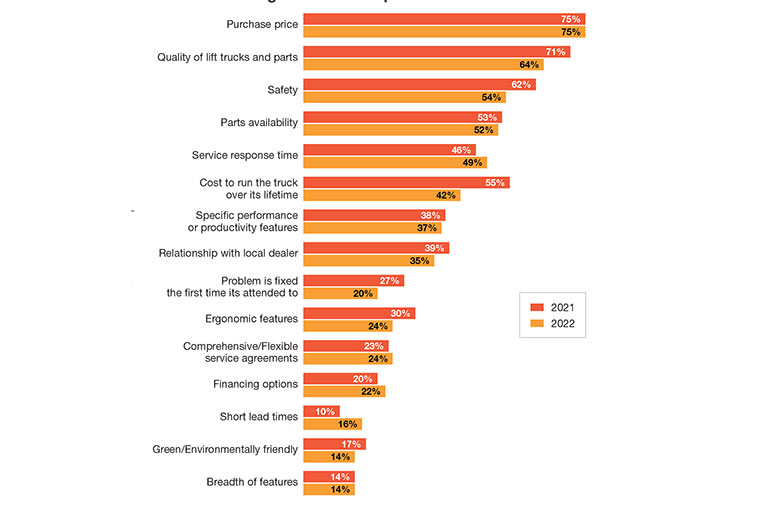
Spanning a wide variety
Companies use various types of lift trucks in their warehouses and distribution centers. More than half of the survey respondents (59%) use electric-powered rider trucks, including counterbalanced, sit-down and stand-up types (Class 1).
Electric-powered narrow-aisle trucks, including orderpickers, side-loaders, turret trucks, stackers and reach trucks (Class 2) are also popular, with 43% of companies employing them in their facilities. Thirty-five percent of companies use IC-powered counterbalanced lift trucks with cushioned tires (Class 4).
目前,31%的公司使用electric-powered pallet trucks—a decline from 44% in 2021—including walkies, riders, low and high lift, and reach types (Class 3). Twenty-five percent of organizations use IC-powered counterbalanced lift trucks with pneumatic tires (Class 5), while 12% use rough terrain lift trucks (Class 7), and 6% are using electric-powered and IC-powered rider-type tow tractors (Class 6).
提升卡车车队大小不同的组织nd range from very small to very large fleets. Thirty-two percent say they have three to nine lift trucks, while 24% say they have less than three vehicles. Meanwhile, 15% have 10 to 14 trucks, 8% have 15 to 24 trucks, and 9% have 25 to 49. At the upper end of the usage spectrum, 5% of respondents work for companies that use anywhere from 50 to 99 trucks, while 7% say they deploy 100+ lift trucks. In 2021, 12% said they had 100 or more lift trucks.
In 2022, the average lift truck fleet size is 20 trucks, a decrease from both 2021 and 2020, when the average fleet size was 27 trucks. Currently, the average truck age is nine years with the oldest trucks being 15 years old. Compared to the previous two years, both of these averages remained steady.
Lift truck purchasing: Likelihood of buying/leasing lift trucks within the next 24 months and number of lift trucks plan to buy/lease
within the next 24 months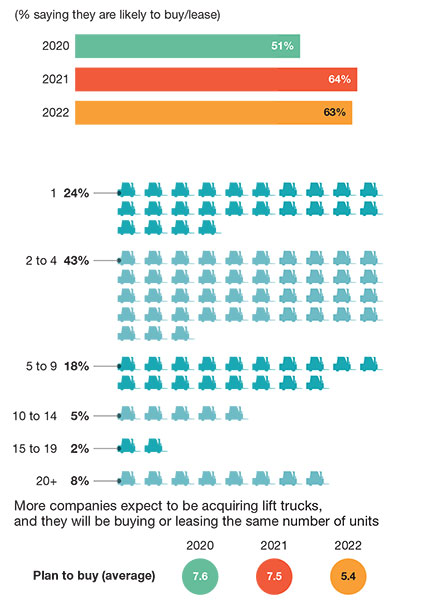
Source: Peerless Research Group (PRG)
Key buying criteria
The most important characteristics companies look for when evaluating lift trucks for purchase or lease include purchase price (75%), quality of lift trucks and parts (64%) and safety (54%). Fifty-two percent of respondents say parts availability is a key factor, while 49% say service response time and 42% consider the amount of money it takes to run the truck over its lifetime.
Other key criteria that companies use when deciding which lift trucks to buy or lease include specific performance or productivity features (37%), the relationship they have with their local dealers (35%), whether a problem is fixed the first time it’s attended to (30%), and ergonomic features (24%).
Twenty-four percent consider comprehensive or flexible service agreements when making the decision, while 22% look at financing options, and 16% consider short lead times. The latter is up from 10% in 2021, with the increase likely created by the ongoing supply chain shortages and the pains that extended order lead times are causing.
Rotating them out
The amount of time companies hang onto their lift trucks varies. Thirty-percent say they replace their vehicles every 10 years or more while 24% rotate their lift trucks out in five to eight years. Fifteen percent do it within eight to 10 years, and 9% replace their vehicles within five years or less. Fifty-four percent of companies expect to acquire new lift trucks as a replacement, while 46% acquire new trucks to add to their current fleets.
When it comes to rotating and disposing of lift trucks, 46% of survey respondents say their dealers take the older trucks at the same time they deliver new ones, while 39% resell the lift trucks being replaced. Thirty-two percent store the lift trucks that are replaced just in case they need them, and 18% hold onto them to use for parts. Forty-seven percent of respondents say they operate a core fleet that they use regularly, versus a less-utilized reserve fleet.
Spending plans for the upcoming 12 months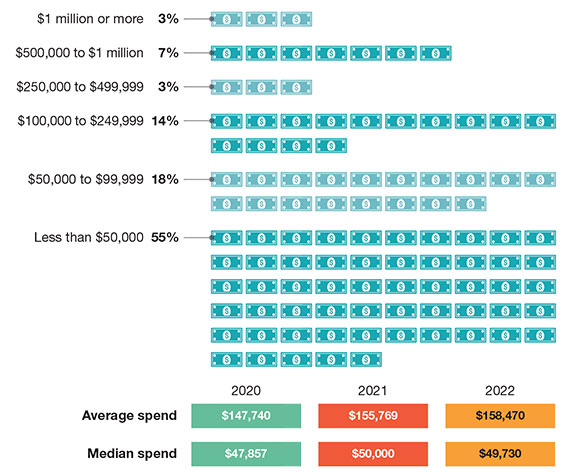
Source: Peerless Research Group (PRG)
Types of lift trucks in use at facilities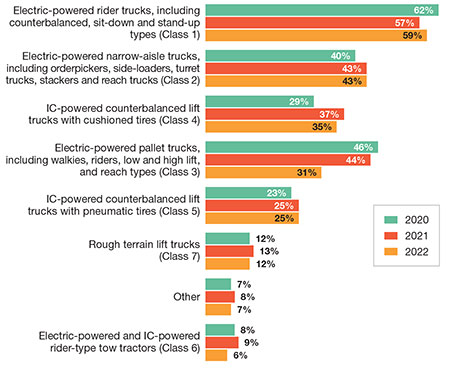
Source: Peerless Research Group (PRG)
Top buying trends
Asked about their preferred acquisition approach for lift trucks, 69% buy their vehicles, 11% lease them (down from 14% in 2021 and 19% in 2020), and 20% of companies use a hybrid approach that includes both purchased and leased lift trucks.
Sixty-three percent of respondents say they’re likely to buy or lease lift trucks within the next 12 to 24 months. When asked how many trucks they plan to acquire during that period, 43% say two to four trucks, while 24% say one truck, 18% want five to nine trucks, and 8% will add 20 or more trucks to their fleets.
Over half (55%) of respondents will spend less than $50,000 on lift trucks in the upcoming 12 months and 18% plan to spend between $50,000 and $99,999. Fourteen percent of companies will shell out $100,000 to $249,999 for new lift trucks and 7% plan to spend somewhere between $500,000 to $1 million on these vehicles over the next two years.
The average expected spend for 2022 is $158,470, which is slightly higher than $155,769 in 2021. For the most part, companies purchase lift trucks directly from the dealer (83%), but 19% will buy directly from the manufacturer and 14% purchase them from another source.
As the workhorses of the warehouse or DC, lift trucks remain an important investment for companies. According to the survey, 40% of companies say the economy and current market factors have little to no impact on how they acquire lift trucks, while 33% say it impacts their decisions to some extent. And 27% say these outside factors impact their lift truck acquisition strategies to a great extent.
Of the companies that say the economy has a great impact on their lift truck purchase decisions, the biggest factors they cite include availability, capacity, interest rates, lead times, and having the money available to buy or lease the vehicles.
Lift Truck parts most likely to purchase or replace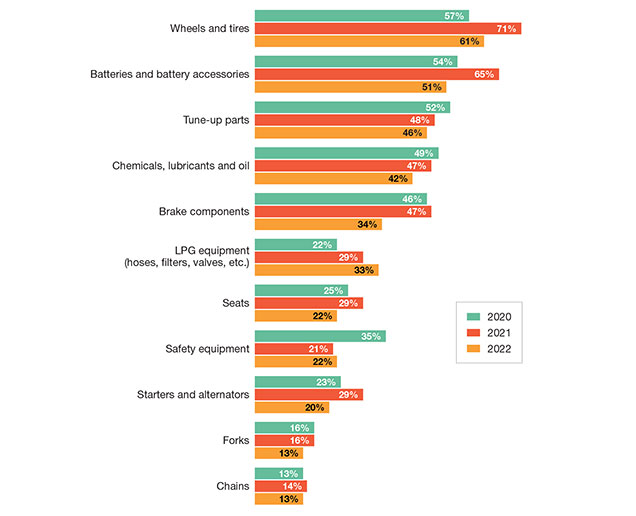
Source: Peerless Research Group (PRG)
梅ntaining and servicing their fleets
在接下来的一年,61%的公司计划purchase or replace wheels and tires for their lift trucks while more than half (51%) will buy or replace batteries or battery accessories and 46% plan to buy or replace tune-up parts for their lift truck fleet. Others will invest in the chemicals, lubricants and oil (42%); brake components (34%); LPG equipment (33%); and seats (22%) needed to keep their fleets operational, productive and efficient.
To train their lift truck operators, the majority of companies (79%) offer internal training programs while 22% rely on dealer training resources and 13% use an independent service provider to train their operators. For servicing and maintaining lift trucks, 43% outsource maintenance to the lift truck dealer, while 28% have in-house staff to handle it, and 26% say they outsource servicing and maintenance to a third party.
Looking ahead, 16% of companies are exploring the use of autonomous or semi-autonomous forklift technology, but 84% have no current plans to adopt this technology. Fleet management software usage declined this year, with 40% of respondents currently using it to manage their fleets (down from 41% in 2021 and 50% in 2020).
Of the companies using fleet management technology, 80% say the software is for tracking maintenance history, 69% are using it to track cost to maintain their lift truck fleets, and 55% are using the platforms for safety management. Of the companies using fleet management technology, 97% of users say those implementations were extremely, very or somewhat successful.

Article Topics
Peerless Research Group News & Resources
32nd Annual Study of Logistics and Transportation Trends: Navigating a shallow pool of resources More robots are coming to a warehouse near you 40th Annual Quest for Quality Awards: Service stars in the new era of collaboration 追求质量2023:北美港口 追求for Quality 2023: Truckload 追求for Quality 2023: Less Than Truckload (LTL) 2023 LTL Study: Partner for reliability More Peerless Research GroupLatest in Logistics
Various economic factors are having an impact on projected import volumes, notes Port Tracker Top CSX executive places a sharp emphasis on railroading as a career path and service at NEARS Israeli war latest wild card in surge behind ‘perfect storm’ of rising diesel prices Ryder announces Chicago expansion, with new Aurora-based distribution center CSCMP EGDE panel examines the impact of supply chain volatility on costs and operations U.S. rail carload and intermodal volumes see annual September gains, reports AAR Supply chains face difficulties in accessing reliable emissions data from suppliers More LogisticsAbout the Author
Subscribe to Logistics Management Magazine

Find out what the world's most innovative companies are doing to improve productivity in their plants and distribution centers.
Start your FREE subscription today.
October 2023
万博2.0app下载

Latest Resources














